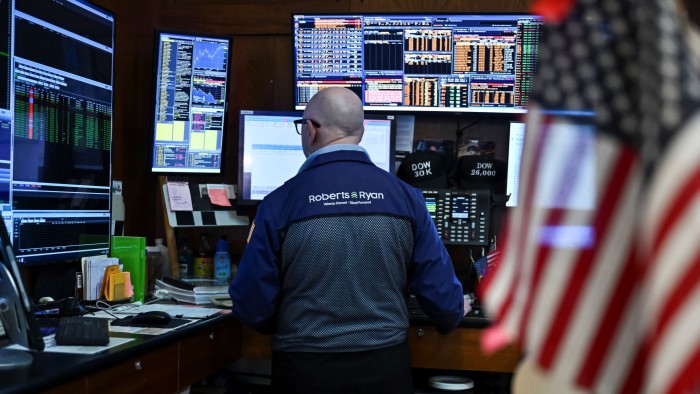Unlock the Editor’s Digest for free
Roula Khalaf, Editor of the FT, selects her favourite stories in this weekly newsletter.
It is time for me to eat some humble pie. Just the one slice, mind you. This also involves a doff of the cap to Graham from Portadown.
I don’t know Graham personally, but our paths crossed during the ugliest days of the global markets shake-out in early April, when US stocks plunged in response to Donald Trump’s supercharged global trade tariffs.
BBC Radio Ulster kindly asked me on air to explain to the masses what was going on. First question: “So Katie, what is a stock market?” (For the record, I unironically love that. There’s genuinely no such thing as a silly question in financial markets.)
Anyway, Graham called in to share his view, which, to paraphrase, was that he didn’t know in any kind of detail how the tariffs would pan out, but he did know that whenever there’s a dip in the US stock market, you should buy it, and he was doing precisely that. If I remember rightly, this was at lunch time in London on April 9. US stocks were down 13 per cent in just a few days at this point and global markets were bleeding out.
Now, I didn’t tell Graham he was wrong. But I did say, while stressing that I was not giving investment advice and never would, that he was braver than I am. Buying the dip is, indeed, a tried and tested tactic with a good record of success but, at that point, let’s just euphemistically say things were not looking great.
We all know what happened hours later. Trump backtracked, stocks exploded higher. If Graham from Portadown was true to his word, and he really did pluck up the courage to buy (he sounded very determined), then he’s up by about 25 per cent on those US stocks since our brief chat. Kudos, Graham.
Even after that point, I didn’t see that the coast was clear, writing a few days later that the case for the buying the dip was just too shaky for me. Hindsight is the most wonderful thing, especially in markets, but in retrospect, Trump really did chicken out, and that changed everything. US stocks, as measured by the S&P 500 blue-chip index, have sprung back to record highs and are up by around 7 per cent so far this year.
“We have this divide,” said Vincenzo Vedda, chief investment officer at Germany’s DWS. “The experts are looking at this and saying ‘this is wrong’ and retail is saying ‘you experts have said for the last 10 years to buy the dip so we’re buying the dip’.”
In any case, they were right. So, one slice of humble pie is duly consumed. Delicious.
I’m not eating the rest of it yet, though. Since that April shake-out in markets, and indeed even before it, most big investment houses outside the US have been taking a fresh and critical look at their US exposure. This is the number-one topic of conversation among institutional investors right now, and it will take considerable time, possibly even years, for it fully to play out.
Each week, men in Florida with Hotmail addresses email to tell me I’m an idiot with, as one charming recent correspondent put it, a “stupid face”, for suggesting this phenomenon is real. No serious money manager, they say, will sell their US stocks and bonds.
But this remains a misreading of the situation. It is not that big investors are unlikely to sell US assets in meaningful volumes. The question is whether they will continue to buy them on the scale we have become accustomed to in a world where US stocks account for something like 70 per cent of developed-market indices. Maybe of every new pound that flows in to a stocks portion pension now, we won’t see 70p head to the US in five years’ time, but something more like 65p or even 60p.
That means a bigger chunk heads to Asia and to Europe — much smaller markets that many global investors have shunned for years. Little wonder, then, that many of them have comfortably outstripped the performance of US stocks in 2025. Several European indices are up by more than 20 per cent this year. Meanwhile, for euro-based investors, the steady drop in the dollar has eaten up any gains. They are still down by some 6.5 per cent on US stocks so far this year in euro terms.
Any big asset manager who is not thinking about how to avoid or at the very least hedge this pain is not doing their job properly, hence the global popularity of building defences against damage from a sliding dollar and the newfound introspection around whether already rather expensive US stocks are really worth the volatility or the political risk.
“We have to break free from the mindset we have had for the past 20 years,” said Talib Sheikh, a portfolio manager at Fidelity International. “Why can’t we have Asia ex-China ex-Japan being a greater part of your portfolio than the US? Why can’t we have Europe as a bigger part? Fads come and go but I think this has more staying power.”
Much of the market disruption from the opening months of 2025 has passed now that we are in the second half of the year, and Graham from Portadown is taking a well-earned victory lap. But the oldest certainties in finance are crumbling.
https://www.ft.com/content/5f59cefc-f94f-448b-abb3-729dbb77aeca



